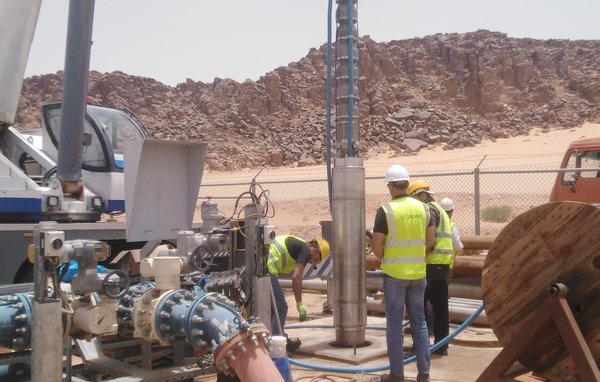OPEX consulting for improving pump reliability and performance across 55 wells

- The Disi aquifer in southern Jordan and Saudi Arabia is 320 km long and 500 m below ground
- Potable water is transferred 325 km to Amman supplying other cities, too
Beneath the desert in southern Jordan and northwestern Saudi Arabia lies the Disi aquifer, 320 km long and 500 m below ground. From 55 wells in the aquifer, water is piped 325 km to Amman the Jordanian capital, as well as other cities on the pipeline.
PLEUGER has been supporting the Operator and the Owner of the well field with constancy from the early stage of the commissioning of the facilities until now. PLEUGER, the Operator and the Owner permanently focus on improving the reliability and the efficiency of the aquifer pumping system.
PLEUGER engineered a range of solutions to tackle the challenges and improve pump reliability and performance:
- Upgrade to the pumps with PLEUGER’s new heavy duty thrust bearings to improve performance and reliability
- New material design to extend mechanical seal life
PLEUGER provided support and assistance in the construction of the Wellfield Network Hydraulic Model completed by the Operator. That model enlightened pathways to improvement for the operation of the pumps and of the well field.
- Start – stop procedures were analyzed and simulated. New procedures were proposed to upgrade the original ones in order to reduce equipment impact and water hammering.
- Operating scenarios for adjusting the settings of the orifice plates at the discharge of the pump rising main are tested, considering the response of the entire hydraulic system. Those scenarios are combined with simulations of adjustments of the number of stages of the pumps in order to find out the best operating strategy in the long run i.e. the strategy that allows finding the lowest specific energy consumption for abstracting the water that is supplied to Amman.
PLEUGER and the Operator share the same strong interest for innovation and do address that subject as an important lever to improve pump monitoring in order to anticipate on incipient decrease of the performance. For instance, addition of new sensors to the pump system has been discussed. These new sensors would be able to monitor vibration and conductivity to detect bearing abrasion and environmental water ingress. This visibility would open up preventative maintenance scheduling, less downtime and increased reliability.